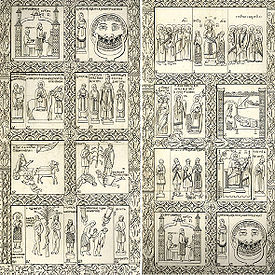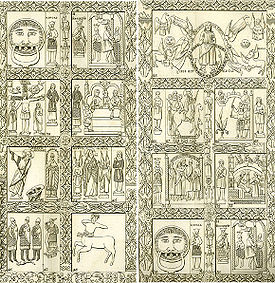.gif)
Rus'-Byzantine War (1043)
Encyclopedia
The final Rus'–Byzantine War was, in essence, an ,unsuccessful naval raid against Constantinople
instigated by Yaroslav I of Kiev and led by his eldest son, Vladimir of Novgorod
, in 1043.
The reasons for the war are disputed, as is its course. Michael Psellus, an eyewitness of the battle, left a hyperbolic account detailing how the invading Kievan Rus'
were annihilated by a superior Imperial fleet with Greek fire
off the Anatolia
n shore. According to the Slavonic chronicles, the Kievan fleet was destroyed by a tempest.
The Byzantines
sent a squadron of 14 ships to pursue the dispersed monoxyla of the Rus'. They were sunk by the Kievan admiral Ivan Tvorimich, who also managed to rescue Prince Vladimir after the shipwreck. A 6,000-strong Kievan contingent under Vyshata
, which did not take part in naval action, was captured and deported to Constantinople. Eight hundred of the Rus' prisoners were blinded.
Vyshata was allowed to return to Kiev at the conclusion of the peace treaty three years later. Under the terms of the peace settlement, Yaroslav's son Vsevolod I
married a daughter of Emperor Constantine Monomachus
. Vsevolod's son by this princess assumed his maternal grandfather's name and became known as Vladimir Monomakh
.

 There are good reasons to believe that the campaign was not over in 1043 (as Greek sources seem to imply), but continued with the Rus' capture of Chersonesos (Korsun') the following year:
There are good reasons to believe that the campaign was not over in 1043 (as Greek sources seem to imply), but continued with the Rus' capture of Chersonesos (Korsun') the following year:
Careful analysis of these facts led Vera Bryusova to conclude that hostilities were renewed in 1044 or 1045, when Vladimir advanced on Chersonesos and captured it, retaining the town until the Byzantines, involved in several other wars, agreed to conclude a favourable treaty with Rus' and give a princess in marriage to his younger brother. If so, the situation would be almost identical to the conquest of Chersonesos by Vladimir the Great, which, according to most Slavonic sources, precipitated the Christianization of Kievan Rus' back in 988.
Bryusova argues that later pious legends confused Vladimir of Novgorod with his more famous grandfather and canonized namesake, who most likely never waged wars against Byzantium. Some late medieval authors went as far as to ascribe this Crimean campaign to another celebrated Vladimir, Monomakh
, who in fact derived his main foreign support from Constantinople. For instance, Vasily Tatishchev
, writing in the 18th century from much earlier sources, erroneously reports that Monomakh engaged a Greek governor of Chersonesos in single combat.
Constantinople
Constantinople was the capital of the Roman, Eastern Roman, Byzantine, Latin, and Ottoman Empires. Throughout most of the Middle Ages, Constantinople was Europe's largest and wealthiest city.-Names:...
instigated by Yaroslav I of Kiev and led by his eldest son, Vladimir of Novgorod
Vladimir of Novgorod
Vladimir Yaroslavich reigned as prince of Novgorod from 1036 until his death. He was the eldest son of Yaroslav I the Wise of Kiev by Ingigerd, daughter of king Olof Skötkonung of Sweden....
, in 1043.
The reasons for the war are disputed, as is its course. Michael Psellus, an eyewitness of the battle, left a hyperbolic account detailing how the invading Kievan Rus'
Kievan Rus'
Kievan Rus was a medieval polity in Eastern Europe, from the late 9th to the mid 13th century, when it disintegrated under the pressure of the Mongol invasion of 1237–1240....
were annihilated by a superior Imperial fleet with Greek fire
Greek fire
Greek fire was an incendiary weapon used by the Byzantine Empire. The Byzantines typically used it in naval battles to great effect as it could continue burning while floating on water....
off the Anatolia
Anatolia
Anatolia is a geographic and historical term denoting the westernmost protrusion of Asia, comprising the majority of the Republic of Turkey...
n shore. According to the Slavonic chronicles, the Kievan fleet was destroyed by a tempest.
The Byzantines
Byzantine Empire
The Byzantine Empire was the Eastern Roman Empire during the periods of Late Antiquity and the Middle Ages, centred on the capital of Constantinople. Known simply as the Roman Empire or Romania to its inhabitants and neighbours, the Empire was the direct continuation of the Ancient Roman State...
sent a squadron of 14 ships to pursue the dispersed monoxyla of the Rus'. They were sunk by the Kievan admiral Ivan Tvorimich, who also managed to rescue Prince Vladimir after the shipwreck. A 6,000-strong Kievan contingent under Vyshata
Vyshata
Vyshata was a Novgorodian general and voivode, whose father is supposed to have been posadnik Ostromir and whose son was another statesman, Yan Vyshatich...
, which did not take part in naval action, was captured and deported to Constantinople. Eight hundred of the Rus' prisoners were blinded.
Vyshata was allowed to return to Kiev at the conclusion of the peace treaty three years later. Under the terms of the peace settlement, Yaroslav's son Vsevolod I
Vsevolod I of Kiev
Vsevolod I Yaroslavich , ruled as Grand Prince of Kiev from 1078 until his death.-Early life:...
married a daughter of Emperor Constantine Monomachus
Constantine IX Monomachos
Constantine IX Monomachos, Latinized as Constantine IX Monomachus , c. 1000 – January 11, 1055, reigned as Byzantine emperor from June 11, 1042 to January 11, 1055. He had been chosen by the Empress Zoe as a husband and co-emperor in 1042, although he had been exiled for conspiring...
. Vsevolod's son by this princess assumed his maternal grandfather's name and became known as Vladimir Monomakh
Vladimir II Monomakh
Vladimir II Monomakh |Basileios]]) was a Velikiy Kniaz of Kievan Rus'.- Family :He was the son of Vsevolod I and Anastasia of Byzantium Vladimir II Monomakh |Basileios]]) (1053 – May 19, 1125) was a Velikiy Kniaz (Grand Prince) of Kievan Rus'.- Family :He was the son of Vsevolod I (married in...
.
Crimean campaign of 1044


- In his 16th-century account of the 1043 campaign, Maciej StryjkowskiMaciej StryjkowskiMaciej Stryjkowski was a Polish-Lithuanian historian, writer and a poet, notable as the author of Chronicle of Poland, Lithuania, Samogitia and all of Ruthenia , amongst other aspects of this work considered the first printed book on the history of Lithuania.-Biography:Maciej Stryjkowski was...
narrates that Yaroslav sent his son Vladimir to seize the Crimean emporia of the Greek empire, notably Chersonesos. - Novgorodian traditions link Vladimir's foundation of the Saint Sophia Cathedral in NovgorodSaint Sophia Cathedral in NovgorodThe Cathedral of St. Sophia in the Kremlin in Veliky Novgorod is the cathedral church of the Archbishop of Novgorod and the mother church of the Novgorodian Eparchy.-History:...
in 1045 with his prior victory over the Greeks. The cathedral formerly boasted the so-called Korsun Treasure, which was reportedly brought to Novgorod by Prince Vladimir (usually identified by medieval authors with Vladimir the Great). Among foreign authors, HerbersteinSigismund von HerbersteinSiegmund Freiherr von Herberstein, , was an Carniolan diplomat, writer, historian and member of the Holy Roman Empire Imperial Council...
and Paul of AleppoPaul of AleppoPaul Zaim, known sometime also as Paul of Aleppo was a Syrian Melkite clergyman and chronicler...
relate that the copper Korsun Gate of the cathedral was seized by the Novgorodians in Chersonesos, where it had been used as a city gate. The extant cathedral gate is decorated with complicated cross symbols, specifically associated by art historians with Chersonesos. Curiously enough, excavations of Chersonesos yielded an inscription reporting that the city gate had to be replaced in 1059. Apart from the gate, the treasure contained gold vessels, the miraculous icon of the TheotokosTheotokosTheotokos is the Greek title of Mary, the mother of Jesus used especially in the Eastern Orthodox, Oriental Orthodox, and Eastern Catholic Churches. Its literal English translations include God-bearer and the one who gives birth to God. Less literal translations include Mother of God...
of Korsun and other early 11th-century Greek items (some of them still in situIn situIn situ is a Latin phrase which translated literally as 'In position'. It is used in many different contexts.-Aerospace:In the aerospace industry, equipment on board aircraft must be tested in situ, or in place, to confirm everything functions properly as a system. Individually, each piece may...
, others looted by Ivan the Terrible after the Massacre of NovgorodMassacre of NovgorodThe Massacre of Novgorod was an attack launched by Tsar Ivan IV’s oprichniki on the city of Novgorod, Russia in 1570. The sheer number of casualties combined with the extreme level of violent cruelty makes this campaign possibly the most vicious in the brutal legacy of the oprichnina.-Paranoia,...
and taken to Moscow). - Having visited KievKievKiev or Kyiv is the capital and the largest city of Ukraine, located in the north central part of the country on the Dnieper River. The population as of the 2001 census was 2,611,300. However, higher numbers have been cited in the press....
in 1048, Roger II of ChâlonsChalonsChalons may refer to:Places* Châlons, in France's Isère département* Châlons-en-Champagne, formerly Châlons-sur-Marne, in the Marne département* Chalon-sur-Saône, in the Saône-et-Loire département* Roman Catholic Diocese of Châlons...
reported that he had seen there the relics of St. Clement of Rome. According to Roger, Yaroslav told him that the relics had been taken by him from Chersonesos, where Clement had been supposedly martyred. Slavonic sources claim that Clement's relics were brought to Kiev from Crimea by Yaroslav's father Vladimir.
Careful analysis of these facts led Vera Bryusova to conclude that hostilities were renewed in 1044 or 1045, when Vladimir advanced on Chersonesos and captured it, retaining the town until the Byzantines, involved in several other wars, agreed to conclude a favourable treaty with Rus' and give a princess in marriage to his younger brother. If so, the situation would be almost identical to the conquest of Chersonesos by Vladimir the Great, which, according to most Slavonic sources, precipitated the Christianization of Kievan Rus' back in 988.
Bryusova argues that later pious legends confused Vladimir of Novgorod with his more famous grandfather and canonized namesake, who most likely never waged wars against Byzantium. Some late medieval authors went as far as to ascribe this Crimean campaign to another celebrated Vladimir, Monomakh
Vladimir II Monomakh
Vladimir II Monomakh |Basileios]]) was a Velikiy Kniaz of Kievan Rus'.- Family :He was the son of Vsevolod I and Anastasia of Byzantium Vladimir II Monomakh |Basileios]]) (1053 – May 19, 1125) was a Velikiy Kniaz (Grand Prince) of Kievan Rus'.- Family :He was the son of Vsevolod I (married in...
, who in fact derived his main foreign support from Constantinople. For instance, Vasily Tatishchev
Vasily Tatishchev
Vasily Nikitich Tatishchev was a prominent Russian statesman, and ethnographer, best remembered as the author of the first full-scale Russian history...
, writing in the 18th century from much earlier sources, erroneously reports that Monomakh engaged a Greek governor of Chersonesos in single combat.

